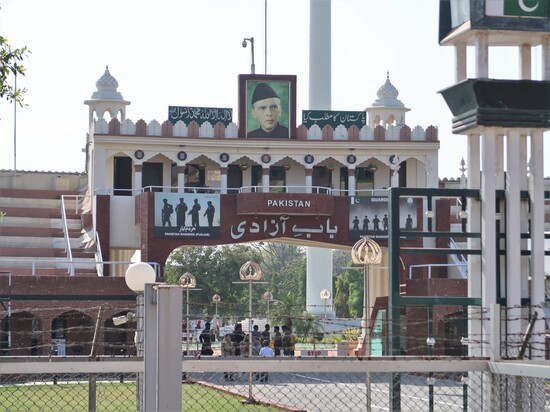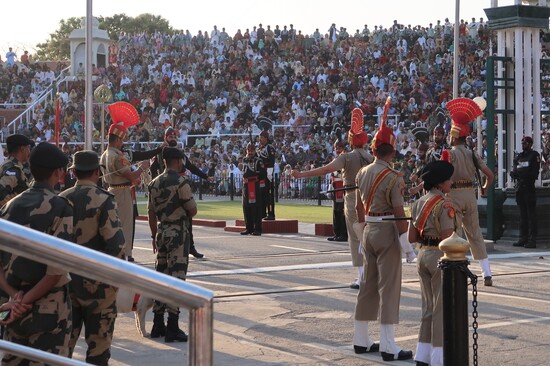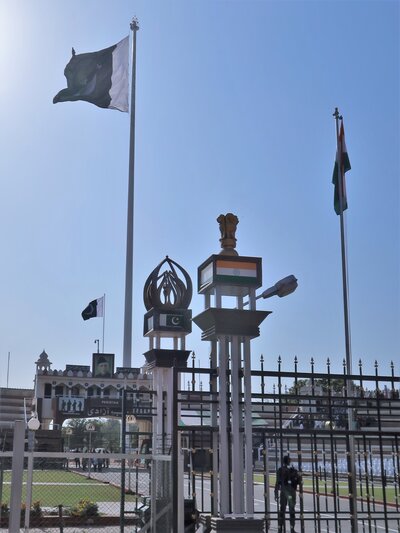Hi Everyone – If you haven’t read PART 1, you should definitely start there, as it provides some great historical context for this post about our time in Amritsar.
—————————————————————————————————————-

The late afternoon air was sweltering, the temp hovering just below 100 degrees, my 30-cent fan no match for a sun this strong. My sweat-drenched back and legs were now melded to the plastic chair I was sitting on, and any attempt to move them resulted in an obnoxiously loud suctioning sound that no one should be subjected to. This was the downside of arriving 90 minutes ahead of the ceremony start time, but had the benefit of securing us second row seats in the “Foreigner Section,” which was pretty much as good of seating as one could hope for. So yes, I was disgustingly sweaty, but I was also pumped to see this Wagah-Attari Border Ceremony that I’d heard so much about.

We were sitting in a semi-circular stadium at the very edge of the Indian border, directly facing another semi-circular stadium on the edge of the Pakistan border. The two stadiums–and countries, for that matter–were separated by parallel barbed wire fences, each with a 10-foot-tall decorative iron gates in the center. Between the two sets of iron gates were two flags, one for Pakistan and one for India. A long single-lane road enters through one stadium and exits out the other, the only way one could cross on land between the two countries (and only by foot, no less!). The stadiums were placed in this location because of the former significance of this road, originally called the Grand Trunk Road, that connected Lahore and Amritsar, which at one time were both part of the state of Punjab in British India.

At the center of the 10,000-person Indian stadium was a giant portrait of Gandhi and the words “BSF: India First Line of Defense”, which I would learn stood for Border Security Forces, the people who patrol the 7,000+ km of border between India and Pakistan (and Bangladesh, China, Nepal, and Bhutan). Directly across from the India stadium was Pakistan’s version, which was crowned by a stoic-looking portrait of Ali Jinnah, the original Prime Minister and “Father” of Pakistan. Jinnah was flanked by photos of the Pakistan Rangers–Pakistan’s name for its border guards–looking regal in their dark green uniforms.

At 5:00 p.m. the fun kicked up a notch as Bollywood tunes filled the air and scores of women poured out through the central arch, stopping just short of a rope that had been erected midway. The women danced their hearts out, their vibrant-colored saris flashing in the sun with the sway of their hips.

You couldn’t help but be energized by their enthusiasm. Nia desperately wanted to join them, but I was a mean mom and said no, as this seemed like an Indian pride moment meant for actual Indians.

30 minutes later the music paused and our attention turned to 10 BSF officers standing atop the first level of the stadium, their ostentatious red-fanned hats resembling the plumage of an exotic bird.

Two female soldiers started the procession by coming down the steps from the first landing and marching in sync to the border gate. Several other singles and pairs followed suit, all eventually coming to a stop in front of the iron gate.

This was no basic marching though! This marching was accentuated with fervent arm swinging, synchronized stomps, and knee-to-nose sky-high kicks. Each officer had their chance to shine and the crowd roared with delight when a particularly-high kick was achieved.

I was so busy paying attention to the show transpiring in front of me that I’d failed to realize an identical procession was taking place on the Pakistan side. It was only when both sets of gates began to magically slide open that I realized the entirety of what was happening, curious to see what would play out next between these two countries with such a long history of conflict.

The last soldier completed an elaborate display of moves and continued down to the now-open gate to meet his Pakistani counterpart in a fierce stare-down and, well, what looked like a dance off. It was hilarious and heart-warming all at the same time and you could tell that everyone was having a lot of fun. I particularly enjoyed the machismo displays, the mustache-preening and the occasional stuck-out tongue.


The final act of the evening was to lower the flags until the following day. Both men stepped forward and began unraveling the rope of their flag.

Once the flags were lowered, both men met in the middle, shook hands, and about-faced as the gates slammed shut for the night.


It was in that handshake that I really started to question my preconceived notions of Pakistan as the “bad guys”. I’m not sure what I expected–maybe some al-Qaeda looking dudes with AK-47s chanting “Death to India (or America),” but there wasn’t any overt hate to be seen. While there was lots of flag waving and patriotic fervor, there was very little sense of vitriol or hate from either side. It was all “yay us,” and not “F you.” Yes, the country has a history of supporting terrorism and has an equally complicated history with the United States as it does India.

But, at the people-to-people level, especially in Punjab, where they used to be part of the same country, things seemed pretty chill. Maybe that’s just nuance or naivety, but I thought the whole event showed that maybe there’s room for the two countries to not exactly be friends, but not enemies either. Obviously one over-the-top ceremony in Punjab is not representative of large-scale geopolitics, but I for one came away a little less scared of Pakistan and a little more introspective about the places I think of as “bad” and whether I need to more consciously challenge the unconscious biases I’ve developed over the years.



